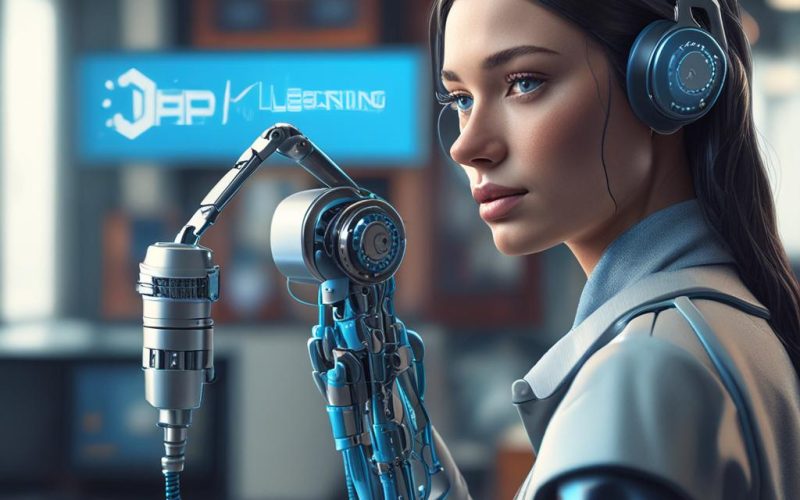Table of Contents Show
Machine Learning and Deep Learning are revolutionizing industries and transforming the way we live and work. These subsets of artificial intelligence have become crucial in various sectors, including healthcare, finance, and technology, by enabling machines to learn from data and make informed decisions. As the demand for intelligent systems continues to grow, it’s essential to understand the differences, similarities, and use cases of Machine Learning and Deep Learning. In this blog post, we’ll delve into the basics, key differences, and applications of these two technologies to help you make informed decisions.
What is Machine Learning?
Machine Learning is a subset of artificial intelligence that focuses on algorithms that learn from data. It involves training models to make predictions or take actions based on patterns and relationships in the data. Common Machine Learning techniques include regression, decision trees, and clustering.
What is Deep Learning?
Deep Learning is a specialized subset of Machine Learning that uses neural networks with multiple layers to analyze complex data. Inspired by the structure and function of the human brain, Deep Learning models can process vast amounts of data, identify patterns, and make accurate predictions.
Key Similarities Between ML and DL
Despite their differences, Machine Learning and Deep Learning share some key similarities:
- Both are subsets of artificial intelligence.
- Both rely on data to train models.
- Both aim to improve performance through learning.
Key Differences Between Machine Learning and Deep Learning
Complexity of Models
Machine Learning models are relatively simple and often require feature engineering, where relevant features are extracted from the data. In contrast, Deep Learning models are complex, with multiple layers that automatically extract features, reducing the need for manual feature engineering.
Data Requirements
Statistics table for Data Requirements
Machine Learning can work well with smaller datasets, whereas Deep Learning requires large volumes of data to train effectively. This is because Deep Learning models have many parameters that need to be tuned, and a small dataset may not provide enough information to train the model accurately.

Computational Power
Machine Learning can run on standard central processing units (CPUs), whereas Deep Learning often requires graphics processing units (GPUs) or specialized hardware due to its computational intensity. This is because Deep Learning models require many calculations to be performed, and GPUs are better suited to handle these tasks.
Interpretability
Machine Learning models are generally more interpretable, as their decision-making processes can be easily understood. In contrast, Deep Learning models are often considered “black boxes” due to their complexity, making it challenging to understand how they arrive at their decisions.

Use Cases and Applications
Machine Learning Applications
Machine Learning has numerous applications, including:
- Fraud detection: identifying patterns in financial transactions to detect fraudulent activity.
- Recommendation systems: suggesting products or services based on user behavior.
- Predictive maintenance: predicting equipment failures to reduce downtime.
Deep Learning Applications
Deep Learning has numerous applications, including:
- Image and speech recognition: identifying objects in images and transcribing spoken language.
- Natural language processing (NLP): analyzing and generating human language.
- Autonomous vehicles: enabling vehicles to navigate and make decisions without human intervention.
Choosing Between ML and DL
When deciding between Machine Learning and Deep Learning, consider the following factors:
- Data availability: Deep Learning requires large volumes of data.
- Computational resources: Deep Learning requires significant computational power.
- Problem complexity: Deep Learning is better suited for complex problems.
Advantages and Limitations
Advantages of Machine Learning
Machine Learning has several advantages:
- Easier to implement and interpret.
- Suitable for smaller datasets.
Limitations of Machine Learning
Machine Learning also has some limitations:
- Limited ability to handle unstructured data.
Advantages of Deep Learning
Deep Learning has several advantages:

- Excels at processing complex, unstructured data.
- Reduces the need for manual feature engineering.
Limitations of Deep Learning
Deep Learning also has some limitations:
- Requires significant computational power and data.
- Lack of interpretability.
Future Trends in ML and DL
The future of Machine Learning and Deep Learning is exciting, with several trends emerging:
- The convergence of ML and DL with other technologies like IoT and edge computing.
- Advances in explainable AI to address DL’s “black box” issue.
- The role of AI ethics in shaping the future of ML and DL.
Conclusion
In conclusion, Machine Learning and Deep Learning are two powerful technologies that have transformed industries and revolutionized the way we live and work. Understanding their differences, similarities, and use cases is crucial for making informed decisions. By choosing the right approach based on the problem at hand, you can unlock the full potential of these technologies and drive innovation.
FAQ Section
Q1: Can Deep Learning be used for small datasets?
Deep Learning is less effective with small datasets, as it requires large volumes of data to train effectively. For small datasets, Machine Learning may be a better option.
Q2: Is Deep Learning always better than Machine Learning?
No, Deep Learning is not always better than Machine Learning. The choice between the two depends on the specific use case, data availability, and problem complexity.
Q3: What programming languages are commonly used for ML and DL?
Python, R, and frameworks like TensorFlow and PyTorch are commonly used for Machine Learning and Deep Learning.
Q4: How do I decide whether to use ML or DL for my project?
Consider the following factors:
- Data size and complexity.
- Computational resources.
- Problem complexity.
Q5: Are Machine Learning and Deep Learning the same as Artificial Intelligence?
No, Artificial Intelligence is the broader field, with Machine Learning and Deep Learning as subsets. Artificial Intelligence encompasses a range of technologies that enable machines to perform tasks that typically require human intelligence.




